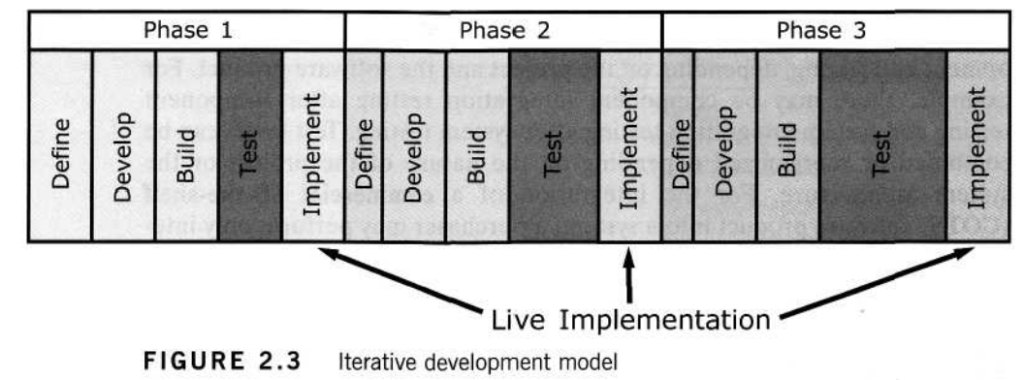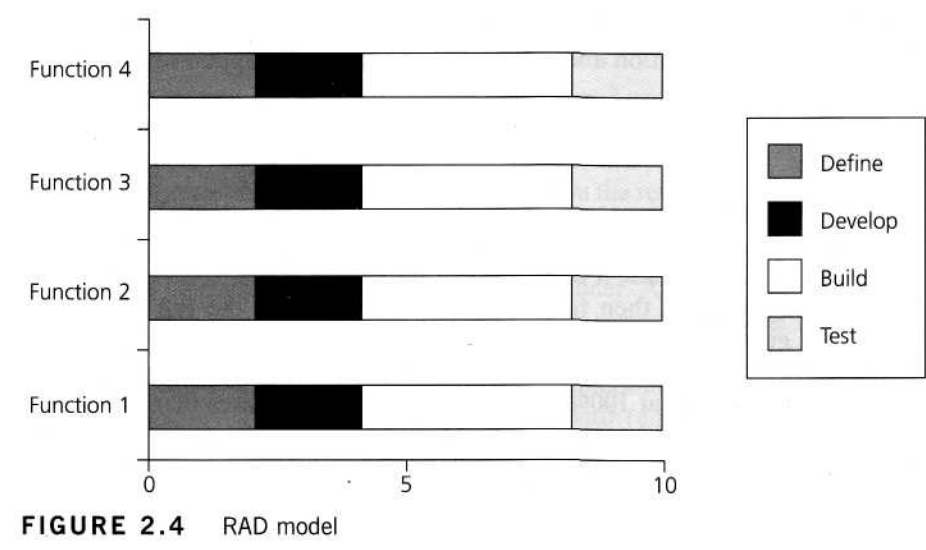2.1.2 Iterative life cycles
Not all life cycles are sequential. There are also iterative or incremental life cycles where, instead of one large development time line from beginning to end, we cycle through a number of smaller self-contained life cycle phases for the same project. As with the V-model, there are many variants of iterative life cycles.

A common feature of iterative approaches is that the delivery is divided into increments or builds with each increment adding new functionality. The initial increment will contain the infrastructure required to support the initial build functionality. The increment produced by an iteration may be tested at several levels as part of its development. Subsequent increments will need testing for the new functionality, regression testing of the existing functionality, and integration testing of both new and existing parts.
Regression testing is increasingly important on all iterations after the first one. This means that more testing will be required at each subsequent delivery phase which must be allowed for in the project plans. This life cycle can give early market presence with critical functionality, can be simpler to manage because the workload is divided into smaller pieces, and can reduce initial investment although it may cost more in the long run. Also early market presence will mean validation testing is carried out at each increment, thereby giving early feedback on the business value and fitness-for-use of the product.
Examples of iterative or incremental development models are prototyping, Rapid Application Development (RAD), Rational Unified Process (RUP) and agile development. For the purpose of better understanding iterative development models and the changing role of testing a short explanation of both RAD and agile development is provided.
Rapid Application Development
Rapid Application Development (RAD) is formally a parallel development of functions and subsequent integration.
Components/functions are developed in parallel as if they were mini projects, the developments are time-boxed, delivered, and then assembled into a working prototype. This can very quickly give the customer something to see and use and to provide feedback regarding the delivery and their requirements.
Rapid change and development of the product is possible using this methodology. However the product specification will need to be developed for the product at some point, and the project will need to be placed under more formal controls prior to going into production. This methodology allows early validation of technology risks and a rapid response to changing customer requirements

Dynamic System Development Methodology [DSDM] is a refined RAD process that allows controls to be put in place in order to stop the process from getting out of control. Remember we still need to have the essentials of good development practice in place in order for these methodologies to work. We need to maintain strict configuration management of the rapid changes that we are making in a number of parallel development cycles.
From the testing perspective we need to plan this very carefully and update our plans regularly as things will be changing very rapidly (see Chapter 5 for more on test plans).
The RAD development process encourages active customer feedback. The customer gets early visibility of the product, can provide feedback on the design and can decide, based on the existing functionality, whether to proceed with the development, what functionality to include in the next delivery cycle or even to halt the project if it is not delivering the expected value. An early business-focused solution in the marketplace gives an early return on investment (ROI) and can provide valuable marketing information for the business. Validation with the RAD development process is thus an early and major activity.
Agile development
Extreme Programming (XP) is currently one of the most well-known agile development life cycle models. (See [Agile] for ideas behind this approach.)
The methodology claims to be more human friendly than traditional development methods. Some characteristics of XP are:
- It promotes the generation of business stories to define the functionality.
- It demands an on-site customer for continual feedback and to define and carry out functional acceptance testing.
- It promotes pair programming and shared code ownership amongst the developers.
- It states that component test scripts shall be written before the code is written and that those tests should be automated.
- It states that integration and testing of the code shall happen several times a day.
- It states that we always implement the simplest solution to meet today’s problems.
With XP there are numerous iterations each requiring testing. XP developers write every test case they can think of and automate them. Every time a change is made in the code it is component tested and then integrated with the existing code, which is then fully integration-tested using the full set of test cases. This gives continuous integration, by which we mean that changes are incorporated continuously into the software build. At the same time, all test cases must be running at 100% meaning that all the test cases that have been identified and automated are executed and pass. XP is not about doing extreme activities during the development process, it is about doing known value-adding activities in an extreme manner.
2.1.3 Testing within a life cycle model
In summary, whichever life cycle model is being used, there are several characteristics of good testing:
- for every development activity there is a corresponding testing activity;
- each test level has test objectives specific to that level;
- the analysis and design of tests for a given test level should begin during the corresponding development activity;
- testers should be involved in reviewing documents as soon as drafts are avail
able in the development cycle.
